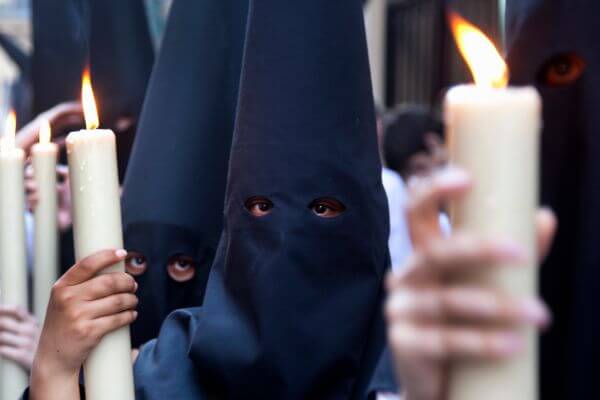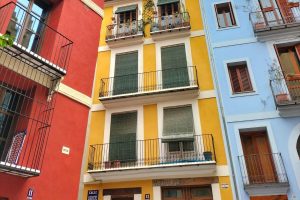In the narrow cobbled streets of Seville, the air is filled with an intoxicating blend of incense and orange blossom. It’s Holy Week, a celebration that transforms the city into a vibrant stage of tradition, devotion, and religious fervor.
Imagine this scene: amid the murmurs of crowds, the sound of bells, and the whispers of saetas, the processions wind through the alleyways, carrying with them centuries of history and passion.
Holy Week in Seville is not simply a festival; it’s a ritual woven into the very essence of the city, rooted in its monuments, squares, and hearts.
Every year, from time immemorial, this city immerses itself in a sea of emotions, where faith intertwines with culture, and devotion is expressed in every gesture and every step.
But what makes Holy Week in Seville so special? It’s the unique combination of elements: the impressive processions, the magnificently crafted floats, the soul-stirring music, and the traditions passed down from generation to generation.
It’s an experience that goes beyond the visual; it’s an encounter with the living history of a city that beats to the rhythm of its beliefs.
Can you imagine walking the same streets that have witnessed centuries of tradition?
Discovering the secrets behind each float and each brotherhood?
On this journey through time and devotion, we invite you to immerse yourself in the fascinating history of Holy Week in Seville, where every detail tells a story and every moment is an unforgettable experience.
Are you ready to be captivated by the charm of this unique celebration in the world?

Origin of Holy Week in Seville
The origin of Holy Week in Seville dates back to the dawn of the Middle Ages, when the first religious processions began to take shape in the city. However, it was in the vibrant setting of the 16th century when this celebration acquired the structure and magnificence that endure to this day.
In the context of the Renaissance, Seville emerged as a prosperous center of trade and culture, where the arts flourished, and religion played a central role in the daily life of its inhabitants.
Religious brotherhoods, in particular, emerged as pillars of the community, combining charitable works with devotion to religious images.
These brotherhoods, composed mainly of laypeople, congregated around churches and hermitages, where they carried out their charitable and religious activities. It was within this context that Holy Week processions began to acquire significant importance, with the brotherhoods being responsible for organizing and participating in these impressive manifestations of faith.
Throughout the centuries, Holy Week in Seville has evolved, adapting to the social and political changes of each era. Key moments, such as the Counter-Reformation in the 16th century and the religious resurgence of the 19th century, have left their mark on the way this festival is lived and celebrated in the city.
The brotherhoods and fraternities have played a fundamental role in this evolution, serving as guardians of traditions and custodians of the sacred images that process through the streets of Seville every Holy Week.
Their influence has been crucial in shaping the celebration, preserving the religious and cultural legacy that defines this Andalusian city.
Thus, from its modest beginnings in the Middle Ages to its current splendor, Holy Week in Seville has been shaped by centuries of history, faith, and devotion, becoming one of the most emblematic and thrilling celebrations in the world.
Cultural heritage of Holy Week in Seville
The cultural heritage associated with Holy Week in Seville is a treasure trove of artistic expression, craftsmanship, and devotion, spanning centuries of tradition and creativity.
From the intricate imagery to the exquisite metalwork, from the soul-stirring music to the masterful craftsmanship, every aspect of this celebration reflects the richness of Seville’s cultural patrimony.
One of the most striking features of Holy Week in Seville is its imagery, with lifelike sculptures known as “pasos” depicting scenes from the Passion of Christ.
These pasos are often carried through the streets on the shoulders of the faithful during the processions, showcasing the remarkable talent of Sevillian sculptors throughout the ages.
Iconic examples include the “Paso de la Borriquita“, portraying Christ’s entry into Jerusalem, and the “Paso del Gran Poder” depicting Christ carrying the cross.
In addition to the imagery, the art of orfebrería, or metalwork, plays a prominent role in Holy Week celebrations. Elaborate silver and gold adornments, known as “resplandores” and “varales” adorn the pasos, adding to their grandeur and beauty.
Examples of exquisite orfebrería can be seen in the intricate silverwork of the “Paso de la Macarena” and the golden details of the “Paso de la Esperanza de Triana“.
Music also forms an integral part of Holy Week in Seville, with solemn melodies and stirring chants filling the air during the processions. Traditional pieces such as “Saetas” and “Marchas procesionales” evoke a range of emotions, from sorrow to hope, enhancing the spiritual experience for both participants and spectators alike.
Beyond the tangible artifacts and performances, Holy Week serves as a vital event for the preservation and dissemination of Seville’s cultural heritage.
Through its rituals and traditions, Holy Week connects the present with the past, ensuring that the artistic achievements of previous generations continue to be celebrated and cherished by future ones.
Tradition and religiosity about Holy Week in Seville
Holy Week in Seville is a deeply religious and symbolic event, commemorating the passion, death, and resurrection of Jesus Christ. It serves as a solemn reminder of the sacrifices made by Christ for the redemption of humanity, inviting believers to reflect on the core tenets of their faith.
Throughout Holy Week, Seville comes alive with a multitude of processions, each one depicting different scenes from the biblical narrative.
From the triumphant entry of Jesus into Jerusalem to his crucifixion and eventual resurrection, these processions unfold like living tableaus, with intricately crafted floats, or “pasos,” depicting the key moments of Christ’s journey.
The processions are made up of various brotherhoods, each with its own distinctive robes and insignias, adding to the visual spectacle and cultural richness of the event.
Penitents, dressed in hooded robes, walk solemnly alongside the pasos, carrying candles or crosses as symbols of their devotion and repentance.
Nazarenos, recognizable by their pointed hoods and tunics, follow in procession, representing different brotherhoods and adding to the solemnity of the occasion.
At the heart of the processions are the costaleros or bearers, who shoulder the weight of the pasos as they wind their way through the streets of Seville. These dedicated individuals undergo rigorous training and preparation to fulfill this sacred duty, demonstrating their commitment to their faith and their community.
Overall, Holy Week in Seville is a powerful expression of religious devotion and cultural heritage, uniting believers in a shared experience of faith and reverence.
Through its rituals and traditions, it offers a poignant reminder of the enduring significance of Christ’s sacrifice and the timeless truths of the Christian faith.
Curiosities about the brotherhoods of Holy Week in Seville
Like everything, Holy Week in Seville is full of anecdotes and curiosities, among which we highlight the following facts about the origins of some of Seville’s most popular brotherhoods:
The Brotherhood of Silence or Primitiva Hermandad de los Nazarenos de Sevilla is perhaps the oldest and was founded in 1340, although oral tradition places its birth a little later in 1355.
The Brotherhood of La Hiniesta, refounded in 1879 after two centuries without activity, comes from another brotherhood that already existed in the 15th century.
The Sacramental Brotherhood of Hope of Triana is a pioneer in the Triana neighborhood and one of the oldest in Seville. In 1418, it was founded as a brotherhood of light with the title of Hope, established in the Royal Parish of Señora Santa Ana and related to the guild of ceramists. In the historical documents of this Brotherhood, it is stated that in 1542 it merged with another corporation, called San Juan Evangelista, from the fishermen’s guild.
The origin of the brotherhood popularly known as “Los Negritos” is linked to the Hospital of Our Lady of the Kings, founded by Archbishop don Gonzalo de Mena y Roelas in 1393.
The Brotherhood of the Great Power, one of the most well-known and popular in Seville’s Holy Week, was founded in 1431, under the title Brotherhood of Power and Passing of Our Lady and Honor of Saint John the Baptist, it appeared as a light brotherhood in the Convent of Santo Domino de Silos of the Order of Saint Benedict. Its foundation is linked to the protectorate of the Duchy of Medina Sidonia.
El Valle was formed by the merger of two brotherhoods from medieval Seville: the Holy Face, founded in 1450, and the Coronation of Christ, founded in 1540.
Everything indicates that Montesión has its origin in a group of disciplinants, gathered around a Crucified in the 14th century, who settled in the monastery of Santa Paula at the end of the 15th century, where said Crucified is currently located, under the name of El Coral.
San Benito was reorganized in 1921 and comes from another brotherhood that owned a hospital in the early 16th century in Triana.
The Brotherhood of the Fifth Anguish was formed in the year 1500 in the convent of El Carmen, although its first rules date from 1541.
The Brotherhood of Christ of Burgos, although its rules date from 1943, was founded in 1888, when members of the Brotherhood of Buen Fin moved to San Pedro due to problems with the Franciscan community.
Unable to take the images, they took that of another brotherhood that existed in the 16th century, known as “the students’ brotherhood“
The Brotherhood and Fraternity of the Holy Crucifix and Our Lady of Grace, from the convent of San Agustín, disappeared at the end of the 19th century and its Christ was lost in the fire of 1936, but a reproduction was made and currently, it is the titular of the San Roque brotherhood.
Holy Week in Seville is a celebration that is intensely experienced in the streets. The processions start in the afternoon and end in the early hours, filling the city with religious images, passion, and the scent of incense.
It’s a true art to live and enjoy!
Recommended Information
Ready to embark on your dream vacation? Contact us today to start planning your unforgettable journey through the beautiful regions of Andalusia and the Valencian Community!




